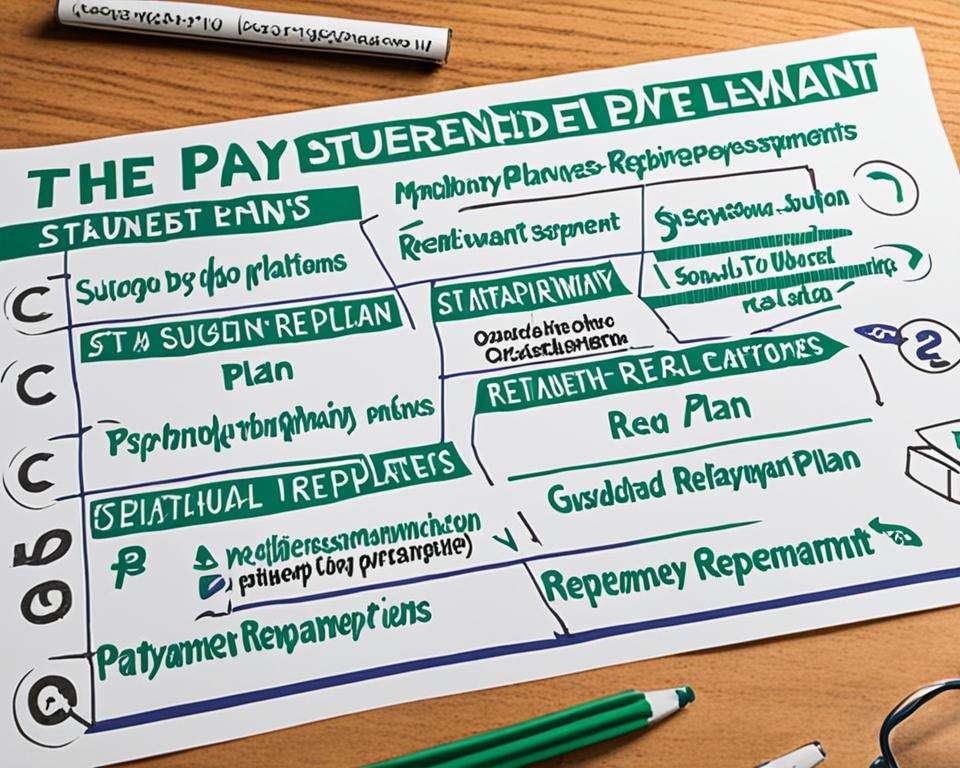Welcome to our comprehensive guide on navigating the world of student loans. Whether you’re a recent graduate or still in school, understanding student loans, repayment options, loan forgiveness, and financial aid is crucial for managing your educational debt effectively. In this article, we will provide expert tips and strategies to help you navigate the complex landscape of student loans, so you can make informed decisions about your financial future.
Student loans are a reality for millions of students across the United States. They serve as a means to access higher education but can also become a significant financial burden if not managed wisely. From federal student loans to private loans, there are various options available, each with its own terms and conditions.
Additionally, understanding the various repayment options is essential to ensure that you can meet your financial obligations without undue stress. Depending on your circumstances, you may qualify for income-driven repayment plans, loan forgiveness programs, or even loan refinancing. It’s important to explore these options to find the strategy that works best for you.
Financial aid is another critical aspect of the student loan landscape. Scholarships, grants, and work-study programs are valuable resources that can help reduce the overall cost of your education. By leveraging financial aid opportunities, you can potentially lower your reliance on loans, minimizing the burden of debt.
Key Takeaways:
- Understanding student loans, repayment options, loan forgiveness, and financial aid is crucial for managing educational debt effectively.
- Explore the different types of student loans available, such as federal and private loans, and consider their terms and conditions.
- Learn about the various repayment options, including income-driven plans, loan forgiveness programs, and loan refinancing.
- Maximize your financial aid opportunities by researching scholarships, grants, and work-study programs.
- By actively managing your student loans, you can take control of your financial future and minimize the burden of debt.
Understanding Student Loan Repayment Options
When it comes to repaying your student loans, understanding the various options available to you is key. Whether you have federal student loans or private student loans, there are different repayment plans to consider based on your individual circumstances. Additionally, exploring the option of student loan refinancing can potentially lower your interest rates and simplify your repayment process.
Let’s take a closer look at the differences between federal and private student loans.
- Federal Student Loans: These loans are funded by the federal government and offer various repayment options, such as income-driven repayment plans and loan forgiveness programs. Federal student loans typically have fixed interest rates and flexible repayment terms.
- Private Student Loans: These loans are issued by private lenders, such as banks or credit unions. Unlike federal loans, the terms and conditions of private student loans vary depending on the lender. Interest rates can be fixed or variable, and repayment options may differ.

When deciding on a repayment plan, it’s important to consider your financial situation and long-term goals. Make sure to research and compare the different repayment options available for your specific type of loan. Additionally, understanding the potential benefits of student loan refinancing can help you make an informed decision.
By refinancing your student loans, you may be able to secure a lower interest rate, which can save you money over the life of your loan. Refinancing can also simplify your repayment by consolidating multiple loans into a single monthly payment.
However, it’s important to note that refinancing federal student loans into a private loan means losing access to federal benefits and programs, such as income-driven repayment plans and loan forgiveness options. Before refinancing, carefully weigh the pros and cons to ensure it aligns with your financial goals.
Choosing the Right Repayment Plan
When it comes to selecting a repayment plan, consider factors such as your income, expenses, and future financial goals. Here are a few popular repayment options:
- Standard Repayment Plan: This plan offers fixed monthly payments over a 10-year term. It’s a good option if you can afford higher monthly payments and want to pay off your loan quickly.
- Income-Driven Repayment Plans: These plans base your monthly payments on your income and family size. They can be a viable option if you have a lower income or anticipate fluctuations in your income over time.
- Graduated Repayment Plan: This plan starts with lower monthly payments that gradually increase every two years. It’s suitable for borrowers whose income is expected to increase steadily over time.
Remember, each repayment plan has its own advantages and considerations. Review the terms and requirements of each plan before making a decision. If you’re unsure which option is best for you, consider reaching out to your loan servicer or a financial advisor for personalized guidance.
Exploring Loan Forgiveness Programs
In today’s world, where student loan debt has reached unprecedented levels, understanding loan forgiveness programs is crucial. This section will focus on loan forgiveness programs, with a particular emphasis on forgiveness options available for federal student loans.
One of the most popular loan forgiveness programs is the Public Service Loan Forgiveness (PSLF) program. Designed for individuals working in public service, the PSLF program provides an avenue for qualifying borrowers to have their federal student loans forgiven after making 120 qualifying payments.
To be eligible for loan forgiveness under the PSLF program, you must meet specific requirements:
- You must have direct federal loans
- You must be employed full-time by a qualifying public service organization
- You must have made 120 qualifying payments
- You must be enrolled in an income-driven repayment plan
It’s important to note that meeting these requirements can sometimes be challenging. Therefore, it’s essential to be well-informed and prepared when navigating the application process for loan forgiveness.
Maximizing Your Chances of Qualifying for Loan Forgiveness
While loan forgiveness programs offer valuable relief to borrowers, it’s crucial to understand the nuances and requirements of each program. Here are some tips to maximize your chances of qualifying for loan forgiveness:
- Research and familiarize yourself with the eligibility criteria for the specific loan forgiveness programs you’re interested in
- Keep accurate records of your employment and payment history
- Submit your annual employment certification form to ensure your progress towards loan forgiveness is properly tracked
- Stay in touch with your loan servicer to address any questions or concerns regarding the loan forgiveness process
By following these steps and staying proactive, you can increase your chances of successfully navigating the loan forgiveness process.
| Loan Forgiveness Program | Eligibility Criteria | Maximum Loan Amount Forgiven |
|---|---|---|
| Public Service Loan Forgiveness (PSLF) | Direct federal loans Full-time employment in eligible public service organizations 120 qualifying payments | No maximum |
| Teacher Loan Forgiveness | Direct federal loans or Federal Family Education Loans (FFEL) Full-time employment as a teacher 5 consecutive years of teaching in low-income schools | Up to $17,500 |
| Income-Driven Repayment Plan Forgiveness | Enrollment in an income-driven repayment plan 20-25 years of qualifying payments | Any remaining balance |
As illustrated in the table above, loan forgiveness programs vary in their eligibility criteria and maximum loan amounts forgiven. Researching and understanding the specific requirements of each program can help you make informed decisions and take advantage of available opportunities for debt relief.
Strategies for Managing Student Loan Debt
Managing student loan debt can be overwhelming, but with the right strategies, you can take control of your finances and pave the way towards a debt-free future. In this section, we will discuss key strategies that will help you effectively manage your student loan debt, including understanding student loan interest rates, avoiding default, and exploring student loan consolidation options.
Understanding Student Loan Interest Rates
When it comes to student loans, understanding the concept of interest rates is crucial. Interest rates determine the additional amount you’ll pay over the loan’s repayment period. It’s important to familiarize yourself with the interest rates associated with your loans and how they impact your overall repayment.
Did you know? When you make payments towards your student loans, a portion of it goes towards paying off the interest, while the rest is applied towards the principal balance.
Quote: “By understanding your student loan interest rates, you can make informed decisions about your repayment strategy and potentially save money in the long run.” – Financial Advisor, Jane Thompson.
Avoiding Student Loan Default
Defaulting on your student loans can have serious consequences on your financial future. It’s essential to stay proactive and avoid default at all costs. Here are some tips to help you prevent student loan default:
- Stay organized and keep track of your loan repayment due dates.
- Create a budget that accounts for your monthly loan payments.
- Consider income-driven repayment plans that adjust your monthly payments based on your income.
- Explore deferment or forbearance options if you are facing financial hardship.
- Communicate with your loan servicer if you are struggling to make payments, as they may offer alternative solutions.
Exploring Student Loan Consolidation
If you have multiple student loans, consolidating them into a single loan can simplify your repayment process and potentially lower your monthly payments. Student loan consolidation combines all your eligible federal student loans into one loan with a fixed interest rate.
Consolidation can provide several benefits, including:
- Easier management of loan payments with one monthly bill.
- Potential access to additional repayment plans.
- Potential eligibility for loan forgiveness programs.

Keep in mind that consolidation may not be the best option for everyone. It’s important to weigh the pros and cons and consider factors such as the impact on interest rates and loan forgiveness eligibility before making a decision.
Comparison of Student Loan Consolidation Options
| Consolidation Loan Options | Interest Rates | Loan Forgiveness Eligibility |
|---|---|---|
| Federal Consolidation Loan | Fixed interest rate | May be eligible for loan forgiveness programs |
| Private Consolidation Loan | Variable or fixed interest rate | Not eligible for federal loan forgiveness programs |
Table: Comparison of Student Loan Consolidation Options
Comparing different consolidation loan options can help you make an informed decision based on your unique needs and goals. Consider consulting a financial advisor or contacting your loan servicer for personalized advice.
Conclusion
In conclusion, effectively managing your student loans is crucial for your financial well-being. Throughout this article, we have explored various tips and strategies to help you navigate the complexities of student loans. By implementing these suggestions, you can take control of your student loan debt and confidently manage your financial future.
One of the key takeaways is understanding the different repayment options available to you. Whether you have federal or private student loans, choosing the right repayment plan can make a significant difference in your monthly payments and overall loan burden.
Additionally, we have discussed the importance of exploring loan forgiveness programs, such as the Public Service Loan Forgiveness (PSLF) program. By understanding the eligibility criteria and application process, you can potentially qualify for loan forgiveness and alleviate a portion of your student loan debt.
Lastly, we have highlighted the significance of actively managing your student loans to avoid default and minimize the impact of interest rates. Exploring options like student loan consolidation can simplify your repayment while potentially lowering your interest rates.
By following these tips and strategies, you can navigate the world of student loans with confidence and successfully manage your financial journey. Remember, taking control of your student loan debt is an investment in your future financial stability.
FAQ
What are the different repayment options for student loans?
There are several repayment options for student loans, including standard repayment, graduated repayment, income-driven repayment plans, and extended repayment. Each plan has its own benefits and considerations, so it’s important to research and choose the one that suits your financial situation best.
What is the difference between federal and private student loans?
Federal student loans are provided by the government and typically offer benefits such as fixed interest rates, income-driven repayment plans, and loan forgiveness options. Private student loans, on the other hand, are offered by banks or other financial institutions and may have variable interest rates and fewer repayment options.
How can I refinance my student loans?
Student loan refinancing involves obtaining a new loan to pay off your existing student loans. This can potentially lower your interest rates and simplify your repayment by combining multiple loans into one. To refinance your student loans, you’ll typically need a good credit score and a steady income.
What is student loan forgiveness?
Student loan forgiveness is a program that allows borrowers to have all or part of their student loan debt forgiven. This can be achieved through working in certain public service jobs, such as teaching or government service, or by making consistent payments under an income-driven repayment plan for a specified period of time.
How does the Public Service Loan Forgiveness (PSLF) program work?
The Public Service Loan Forgiveness (PSLF) program offers loan forgiveness to individuals who work for qualifying employers, such as government or nonprofit organizations, and make 120 eligible payments under an income-driven repayment plan. After meeting these requirements, the remaining balance of their federal student loans may be forgiven.
What should I do if I can’t afford my student loan payments?
If you’re struggling to afford your student loan payments, it’s important to explore options such as income-driven repayment plans, deferment, or forbearance. These programs can help temporarily lower or pause your payments based on your financial situation. It’s crucial to contact your loan servicer to discuss your options and avoid defaulting on your loans.





